THE HORSE
|
As one of the three major components of saddle fit the breed and conformation of the horse needs to be considered in saddle fit. A horse’s conformation will change over time for various reasons.
It is primarily the horse owner’s responsibility to consider the following to insure a positive saddle fit over time.
|
Breed and breeding
|
The breed and breeding will influence saddle fit. The western saddle has developed over the years based primarily on the body type of the quarter horse. Therefore, the majority of tree maker's measurements/patterns and saddle maker's designs/techniques are based on the quarter horse body type, which have generic sub categories of regular quarter horse, semi-quarter horse and full quarter horse. New blood lines within the quarter horse breed are yielding a body type that is not the norm for the quarter horse body type. While there has always been other breeds in the western riding discipline, the frequency and numbers have been increasing. Mules and the Arabian have had a niche in western riding discipline for sometime with their own saddles/trees for their body types. One or two the large production saddle companies have begun to offer saddles/trees to fit gaited horses, draft horses, etc. body types. It is noted by one saddle maker that the Tennessee Walker ( a gaited horse) was a preferred choice of many US Forest Service rangers using saddles with Quarter horse bars. Also, another saddle maker has observed that in the Arabian breed; new bloodlines have been developed where the standard Arabian tree does not fit, but a Quarter horse tree does.
With the majority of saddles/trees made for the general quarter horse body type, the introduction of other breeds and new bloodlines within the quarter horse breed with other body types, makes achieving positive saddle fit problematic.
|
Weight gain or loss
|
Weight gain or loss will effect how a saddle fits. How this effects the saddle fit will depend upon the individual horse and saddle. Weight gain or loss and fitness are closely related as fitness level can effect weight gain or loss.
The English discipline addresses this factor in the basic design of the saddle. A traditionally build English saddle is designed with a flocked panel providing an interface between the saddletree and the horse’s back. This flocked panel allows the saddler to add, subtract, or rearrange the flocking with in the panel to fine-tune the fit and balance of the saddle. In the western discipline this is accomplished with saddle blankets and pads.
In general, weight gain or loss in the wither or saddle pocket area may cause the existing saddle to ride higher or lower on the withers. How the weight gain or loss manifests itself will depend on the individual horse.
Possible problems could be:
Pinching at the point where the swell meets the bar. (FIGURE 1 and exhibit A)
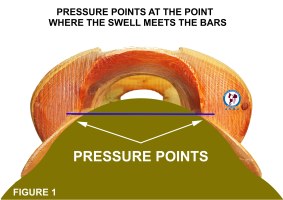 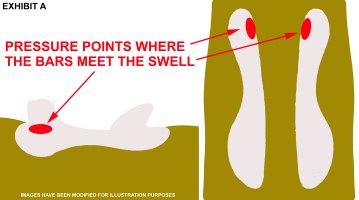 Pinching at the bottom of the bar. (FIGURE 2 and exhibit B)
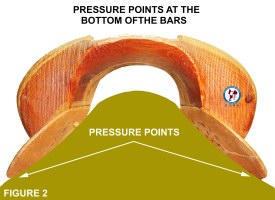 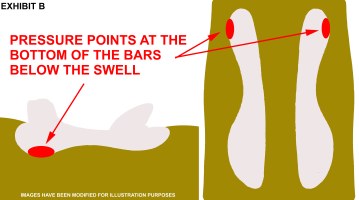 The bottom of the swell rubbing the top of the wither. (FIGURE 3 and exhibit C)
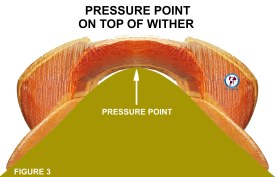 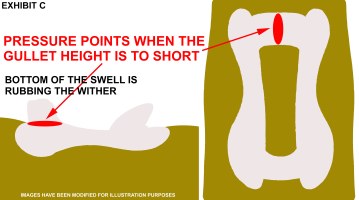  Also, with weight gain or loss there may be a change in the top-line. If the top line becomes flatter, the topline will have less rock than the rock in the bars of the existing saddle. This causes the saddle to “rock” and to place more and unequal weight and pressure in the center of the saddle. Also, with weight gain or loss there may be a change in the top-line. If the top line becomes flatter, the topline will have less rock than the rock in the bars of the existing saddle. This causes the saddle to “rock” and to place more and unequal weight and pressure in the center of the saddle.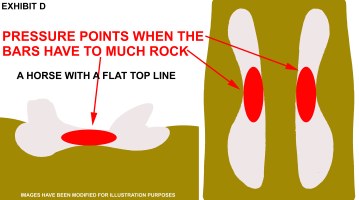 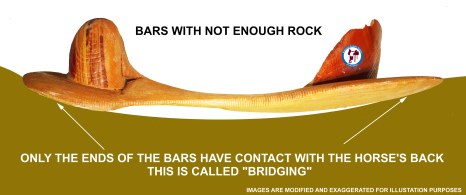 If the top line drops, more rock will be added to the top-line and the existing saddle then may “bridge”. “Bridging” means that the curve in the horse’s back is greater than the rock (curve) in the bars of the existing saddle and only the ends of the bars have contact with the horse’s back resulting in four pressure points. If the top line drops, more rock will be added to the top-line and the existing saddle then may “bridge”. “Bridging” means that the curve in the horse’s back is greater than the rock (curve) in the bars of the existing saddle and only the ends of the bars have contact with the horse’s back resulting in four pressure points.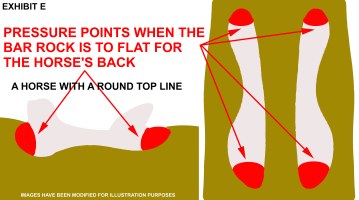 |
Fitness
|
The level of fitness may have an effect on saddle fit and will depend upon the individual horse and saddle. As the muscle tone changes with levels of conditioning, the conformation of back can be altered similar to the changes to the top line from weigh gain or loss. Also, if the horse develops heavier shoulder muscles with conditioning, the front of the skirts may start to rub the shoulder and inhibit the movement of the shoulder.
|
Age
|
The age of a horse will influence saddle fit. The biggest problem is the young horse. A horse under the age of around six is in the process of developing their conformation and major changes in conformation can be expected. The chances of a saddle that fits a horse at three years of age will fit a six years of age is unlikely. Because of this, some saddle makers will not or are hesitant to build a saddle for a horse under the age of six. Another age problem is, as a horse ages typically the top line will drop to some degree. See the examples of a 4 year old gelding and an aged gelding.
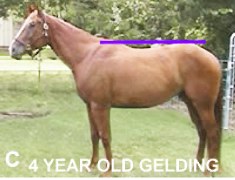 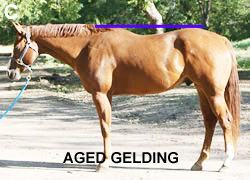 |
Mare after having a foal
|
When a mare has a foal there is a tendency for the mare's top line to drop or in other words to become a little swayback. This can cause the saddle to bridge because the existing saddle does not have enough rock in the bars to accommodate the drop in the top line.
|
Abnormalities in conformation
|
Abnormalities in conformation will always need to be considered in saddle fit. (The fact that an abnormality exists will effect the level of positive saddle fit that may be achieved, which will be lower than normal or may not be achievable.) These conformation abnormalities are many and varied. One conformation abnormality that is some what common is the “downhill” horse. A “downhill” horse is one where the hindquarters are higher than the withers. FOR AN EXAMPLE CLICK HERE
|
Injuries
|
Injuries can effect saddle fit. For example, a leg injury can effect how the horse moves as it compensates for the injury. In compensating for the injury the muscle structure may change thus effecting the existing saddle’s fit.
|
NOTE : The images are modified and exaggerated for illustration purposes. The actual measurements and differences are small and therefore are not easily discernable. The profiles of the body types are based on actual profiles.
|
e-mail mailto:info@saddlemakers.org
Copyright 2005 - 2016 American Saddle Makers Association, Inc.
